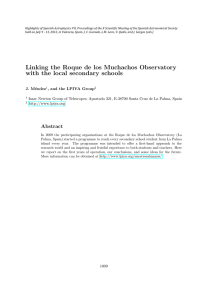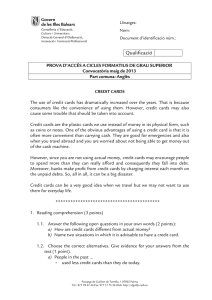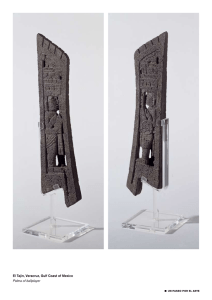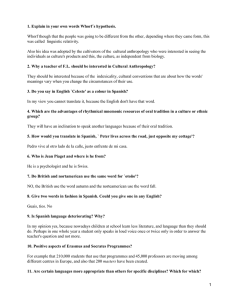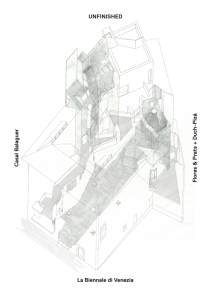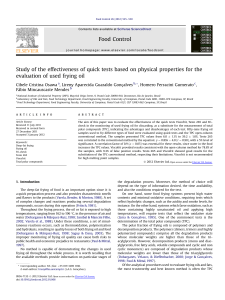Language and Literature: Ricardo Palma and Juan Goytisolo
Anuncio
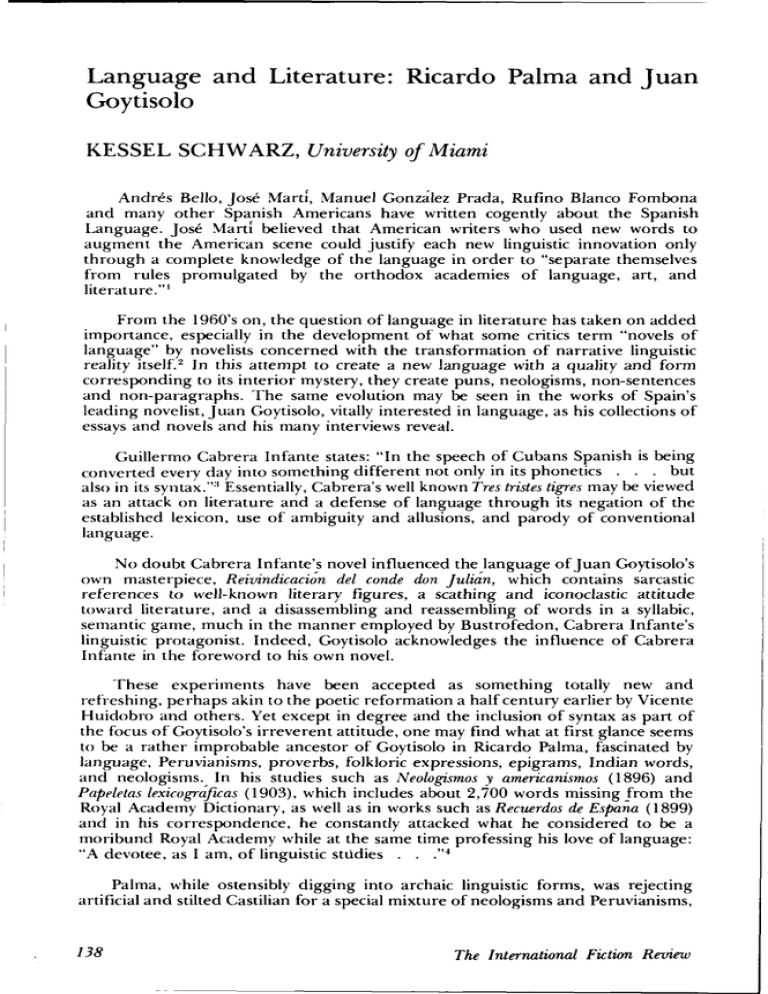
Language and Literature: Ricardo Palma and J u a n Goytisolo KESSEL SCHWARZ, University of Miami Andres Bello, José Marti, Manuel Gonzalez Prada, Rufino Blanco Fombona and many other Spanish Americans have written cogently about the Spanish Language. José Marti believed that American writers who used new words to augment the American scene could justify each new linguistic innovation only through a complete knowledge of the language in order to "separate themselves from rules promulgated by the orthodox academies of language, art, and literature."' From the 1960's on, the question of language in literature has taken on added importance, especially in the development of what some critics term "novels of language" by novelists concerned with the transformation of narrative linguistic reality itself.2 In this attempt to create a new language with a quality and form corresponding to its interior mystery, they create puns, neologisms, non-sentences and non-paragraphs. T h e same evolution may be seen in the works of Spain's leading novelist, Juan Goytisolo, vitally interested in language, as his collections of essays and novels and his many interviews reveal. Guillermo Cabrera Infante states: "In the speech of Cubans Spanish is being converted every day into something different not only in its phonetics . . . but also in its syntax."'1 Essentially, Cabrera's well known Très tristes tigres may be viewed as an attack on literature and a defense of language through its negation of the established lexicon, use of ambiguity and allusions, and parody of conventional language. No doubt Cabrera Infante's novel influenced the language of J u a n Goytisolo's own masterpiece, Reivindicacion del conde don Julian, which contains sarcastic references to well-known literary figures, a scathing and iconoclastic attitude toward literature, and a disassembling and reassembling of words in a syllabic, semantic game, much in the manner employed by Bustrofedon, Cabrera Infante's linguistic protagonist. Indeed, Goytisolo acknowledges the influence of Cabrera Infante in the foreword to his own novel. These experiments have been accepted as something totally new and refreshing, perhaps akin to the poetic reformation a half century earlier by Vicente Huidobro and others. Yet except in degree and the inclusion of syntax as part of the focus of Goytisolo's irreverent attitude, one may find what at first glance seems to be a rather improbable ancestor of Goytisolo in Ricardo Palma, fascinated by language, Peruvianisms, proverbs, folkloric expressions, epigrams, Indian words, and neologisms. In his studies such as Neologismos y americanismos (1896) and Papeletas lexicograficas (1903), which includes about 2,700 words missing from the Royal Academy Dictionary, as well as in works such as Recuerdos de Espana (1899) and in his correspondence, he constantly attacked what he considered to be a moribund Royal Academy while at the same time professing his love of language: "A devotee, as I am, of linguistic studies . . ."4 Palma, while ostensibly digging into archaic linguistic forms, was rejecting artificial and stilted Castilian for a special mixture of neologisms and Peruvianisms, 138 The International Fiction Review a combination of the castizo and the americano through which he managed to emphasize "curious and personal idiomatic creations." 5 He proposed fitting the language to multiple views, gave it meaning on many levels of abstraction, much in the fashion of contemporary writers, and created variants and curious turns and twists of language to meet his artistic purposes. His blend of "words, phrases, and turns, taken alternatively from the mouth of the common people who swarm in markets and taverns, and from the books and other ancient writings of the sixteenth and seventeenth centuries,"" reveals that like Goytisolo, who professes to profane classical texts, he had to have a great knowledge of classical language and popular speech in order to be able to reproduce the living document and to restore the original force of words. Palma offers us the same kind of burlesque of official Peru found in Govtisolo's mockery of a static Spain. He uses the equivalent of associative chains, irony, and malicious portraits in satirizing literary and linguistic intransigence, although the contemporary writer's devotion to lavatory graffiti is matched, in Palma's case, only by his insistence on new and funny words. A master of locutions, Palma delights us. as does Goytisolo, with his semantic and phonetic implications. He believed that an author, in order to convey humor, had to know the very nature of language and "to make a serious study of the structure of sentences, of the euphony and rhythm of words . . ."T His tolerant contempt for some figures of the past matches that of Goytisolo for the giants of his country's literature, and he also uses irony, tongue in cheek puns, and words with double meanings. His attacks on what he calls "the impropriety, unsuitability, and vulgarity in the form of our bureaucratic communications" (TPC, pp. 1510-16) reflect, in a more traditional way, Goytisolo's reproduction of Don Alvaro's discourse in Reivindicacion del conde don Julian." Goytisolo differs in the intensity, to the point of irrationality, in his persecution of the "marvelous language of the Poet, vehicle necessary for betrayal, your beautiful language," 9 and in his insistence on the need for multilevel and ambiguous expressions through which to launch an attack on the social and political status quo. Goytisolo feels the need to destroy linguistic myths as part of his forays against cultural and historical values and that his duty, as a modern writer, is "that of being myth destroyer."' 0 Palma also saw the need for change and realized that the younger generation in his country "neither loves nor hates Spain; it is indifferent to her."" Both writers picked up the sound of the adolescent of the street and the unique verbal contours of living Spanish, but Goytisolo is aggressively ideological and Palma is not. Ricardo Palma, at various times in his speeches and writings, mentions his efforts to preserve the purity of the language in spite of giving it a contemporary flavor through his use of current dialect, but his love for linguistic purity seems reserved almost exclusively for Spanish syntax: "The spirit, the soul of languages, lies in its syntax more than in its vocabulary. Enrich the latter, revere the former, that is our doctrine" (TPC, p. 1380). He repeats this refrain a number of times: "For me, purity must not be sought through vocabulary but rather through correct syntax, for syntax is the soul, the characteristic spirit of all tongues." 12 Juan Goytisolo also believes in being true to language: "The oscillation of the writer between ideal and effective language is not a secondary and circumstantial p h e n o m e n o n ; p r o b i n g more t h o r o u g h l y we can affirm, on the contrary . . . that it is situated in the very center of artistic creation."" Goytisolo sees more clearly than Palma that questioning so-called sacred linguistic cows must also undermine the very foundations of Spanish, neither excluding syntax nor any other aspect of language in his "implacable criticism of that stale Castilian prose which is, at the same time, a sanctuary and bank of sublime values of Classic Style."' 4 Ricardo Palma and Juan Goytisolo 139 And Palma, too, in spite of professing love for the syntactical integrity of his native tongue, chides those who strive for a virginal Castilian, for languages, he claims, "are not virgins: they are mothers, and fecund mothers who are always providing from the claustrum of their brain through the opening of their lips new children to the world of love and human relations" (TPC, p. 1380). He rejects the "anemic lexicon of Castile" (TPC, p. 1541) and reiterates that one must be prepared to sacrifice the purity of Castilian to be truthful to a living Spanish.' 5 He argues that one should have the right to create any word necessary to convey an expression and to realize the peculiar potentialities of his native speech, that Peruvian is not Castilian, and that new flexibility and meanings are needed to have a living and not a dead language. This revolution in language, "an irresistible imposition of the twentieth century" (TPC, p. 1506), is imperative because a "liturgical language is a language condemned to die" (TPC, p. 1540). Goytisolo, for his part, states that one can talk of the occupation of a language as well as the occupation of countries by an enemy force: ". . . a language controlled by an all embracing caste which mutilates its expressive possibilities by exercising a violence, concealed beyond its virtual significance." 16 He believes with Palma that Spanish intransigence may well have created two languages, an American one and a Spanish one, and that a language which reveals neither evolution nor adaptability to new forms, "is on the road to becoming a liturgical language or dead one" (TPC, p. 1507). Goytisolo finds modern Spanish a refined and anemic language, an imprisoned entity, "language incapable of capturing and expressing the novelty and complexity of the modern world and condemned, therefore, to a dead end and to the cemetery of finished styles . . ."' 7 T h e Royal Academy is a favorite target for both Goytisolo and Palma. In Neologismos y americanismos, Recuerdos de Espana, and in a series of letters, Palma complains about Academy intransigence to changes in language or the acceptance of Americanisms. He laments the fact that the only potential tie between Spain and the New World is language, a fact the Royal Academy refuses to recognize, to its sorrow; for new expressions and forms will prevail because "to exclude or condemn them there exists no institution sufficiently powerful or authorized . . ."' 8 He praises the American spirit of Castelar for accepting new modes of expression in spite of an "intransigent academic majority" (TPC, p. 1352); contends that l a n g u a g e , i n d e p e n d e n t of all rules, will survive, "in spite of the Academicians . . ." (TPC, p. 1381); rejects the Academy dictionary as "a cordon sanitaire between Spain and America" (TPC, p. 1383) and as a "restrictive measuring stick" (TPC, p. 1509); and states that usage and not "the doctors . . . those who impose such and such a word" will prevail (TPC, p. 1507). He rejects the Academy view that languages are vestal virgins whose purity they are charged to preserve as ridiculous as the Academy itself, for him "of slight importance" (TPC, p. 1542). He reiterates that Academy authority simply turns writers and young Americans away from the study of language and literature (TPC, p. 1548). Fifty million Spanish Americans are the true owners of the language because, in truth, Castilian has become, even in Spain, little more than regional tongue (TPC, p. 1539). J u a n Goytisolo also believes that the domination of Castilian over other Spanish-speaking countries is an unjust, anachronistic, prejudicial, and false condition. T h e Academy, he maintains, is not "the temple . . . of Classic Style and the musty, chaste prose . . . with which it cradles its ears . . . can in no way serve as a model for anybody . . . society and not grammarians create language . . . Frequently what they call incorrect . . . is but the expression of a new way of looking at things . . ."' 9 140 The International Fiction Review Ricardo Palma's ironie tone in his attacks on the Academy differs only in degree from that of Goytisolo. Palma says: "Rather let the celestial dome collapse on the Academy, and the language and all of us perish than to allow entrance into the Dictionary the word 'gubernamental' . . ."; "do not boast of being a greater hairsplitter than an academic flea" (TPC, pp. 1507-08; 1510). His lexical congeries lack the sometimes coarse implications of his twentieth century counterpart, but he utilizes what some might consider deliberately solecistic transcriptions. Even though Goytisolo lacks the at times respectful reverence of Palma for Spanish syntax, he, too, metamorphosing his language, is unable to destroy it. He vents his wrath, instead, on the Royal Academy and its stuffiness through a burlesque of its entrance speeches. Don Alvaro's death rattle of cu-cu-cu after his fiery speech filled with hyperbole, antithesis, transitions, and metaphors, 2 " is but a part of the equation. Count Julian and Goytisolo cannot use their language, for Spanish authorities proclaim it to be their private property: ". . . from pulpits, from academic chairs, from speakers' platforms the Hispanos proudly proclaim their property rights over language it is ours, ours, ours, they say . . . we transported it to eighteen nations who today speak and think, pray, sing, write as we do daughter nations and their children our grandchildren are also Castilians . . . we still have the Word . . . you must rescue your lexicon: dismantle the age-old linguistic fortress: . . . paralyze the circulation of language: suck dry its The new writers of Spain and Spanish America boast of their freedom from linguistic restraints and from what they believe to be an institutionalized, petrified language. Without denigrating their efforts to create and to use a new language, or denying the emergence of what may be a new spirit of linguistic concern to match the other twentieth century technical innovations of interior monologue, flashbacks, temporal experimentation, simultaneous dialogue, and a new sensibility in a world without apparent values, one concludes that they offer us only relatively old wine in somewhat new bottles. Language, of necessity, reflects the disintegration of human and social relationships, and, in a demythified world of drugs, disillusion, and dehumanization, writers need equivalent expressions to match their oftentimes grotesque visions of life. Carlos Fuentes sees the search for language as "a temporal return to the fount of language . . . to encounter a language which is at long last the answer of the writer as much to the exigencies of his art as to the needs of his society, and I believe that herein lies the possibility of contemporaneity." 22 One may accept the anticultural aspects of Goytisolo's fiction and the contention of critics like Rodriguez Monegal about the creation of new relationships between the modifications of the individual and his reality while at the same time insisting that, linguistically speaking, the search for artistic authenticity among contemporary writers differs only in degree from that of other generations. Palma was responding in the nineteenth century to invariable artistic exigencies through his language and unusual connotations, much as Goytisolo, in his experimentation with new form, was reacting to what he termed linguistic myths. In the final analysis, both, true artists, rejected the concept of language as something inherited or definitive, adapted words and sentences to each nuance of content, and created a highly original, metaphorically informative, and authentic language, as they explored their transmuted realities in compelling and stylistic interpretations of society and history. Ricardo Palma and Juan Goytisolo 141 NOTES 'Roberto Agramonte, Marti y su conception del mundo (Barcebna: Editorial Universitaria, Universidad de Puerto Rico, 1971), p. 50. 2 Emir Rodriguez Monegal, "Diario de Caracas," Mundo nuevo, No. 17 ( 1967), pp. 22-23. In El arte de narrar (Caracas: Monte Avila, Editores, 1968), pp. 269-292, he discusses language strata and the correspondence of linguistic levels to ontological and ethnic realities. 3 J. Corrales Egea, "Escritores hispanoamericanos en Paris, I. Con Guillermo Cabrera Infante," Insula, No. 195(1963), p. 7. 4 See letter to Daniel Granada in Ricardo Palma, Tradiciones peruanas complétas (Madrid: Aguilar, 1961), p . 1534. Further citations in the text are to this edition, hereafter cited as TPC. 5 Raimundo Lazo, Vigil, Pabna, Gonzalez Prada (Havana: Cultural, S. A., 1943), pp. 29-21. 6 Ricardo Palma, Tradiciones peruanas, (Madrid: Espasa-Calpe, 1939), II, p. 7. 'Jose Miguel Oviedo, Genio y figura de Ricardo Palma (Buenos Aires: Editorial Universitaria, 1965), p. 165. 8 Juan Goytisolo, Reivindicacion del conde don Julian (Mexico: Joaquin Mortiz, 1970), pp. 177-181. 9 Reivindicacion . . ., p. 70. '"Declaracidn de J u a n Goytisolo. Norte, No. 4-6 (1972), p. 91. ' 'Guillermo Feliu Cruz, En tomo de Ricardo Palma (Santiago de Chile: Prensas de la Universidad de Chile, 1933), II, 190. n En tomo anarchy." 13 . . ., p. 212. See also, Jose Miguel Oviedo, p. 164: "What I don't want, friend, is linguistic Juan Goytisolo, Elfurgon de cola (Paris: Ruedo Iberico, 1967), p. 136. "Elfurgon . . ., p. 183, f.n. 4. '"Ricardo Palma, Tradiciones peruanas (Madrid: Espasa-Calpe, 1939), V, p. 369. '"Juan Goytisolo, Obra inglesa de D. Jose Maria Blanco White (Buenos Aires: Ediciones Formentor, 1972), 72. P. l7 Juan Goytisolo, Elfurgon de cola, p. 48. '"Guillermo Feliu Cruz, p. 213. ' 9 Juan Goytisolo, Elfurgon de cola, p. 135. 20 Juan Goytisolo, Reivindicacion del conde don Julian, p. 181. 2 'Reivindicacion . . ., pp. 192-196. "Carlos Fuentes, "Situacion del escritor en America Latina," Mundo nuevo, No. 1 (1966), p. 17. 142 The International Fiction Review
